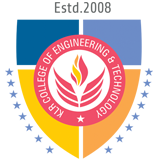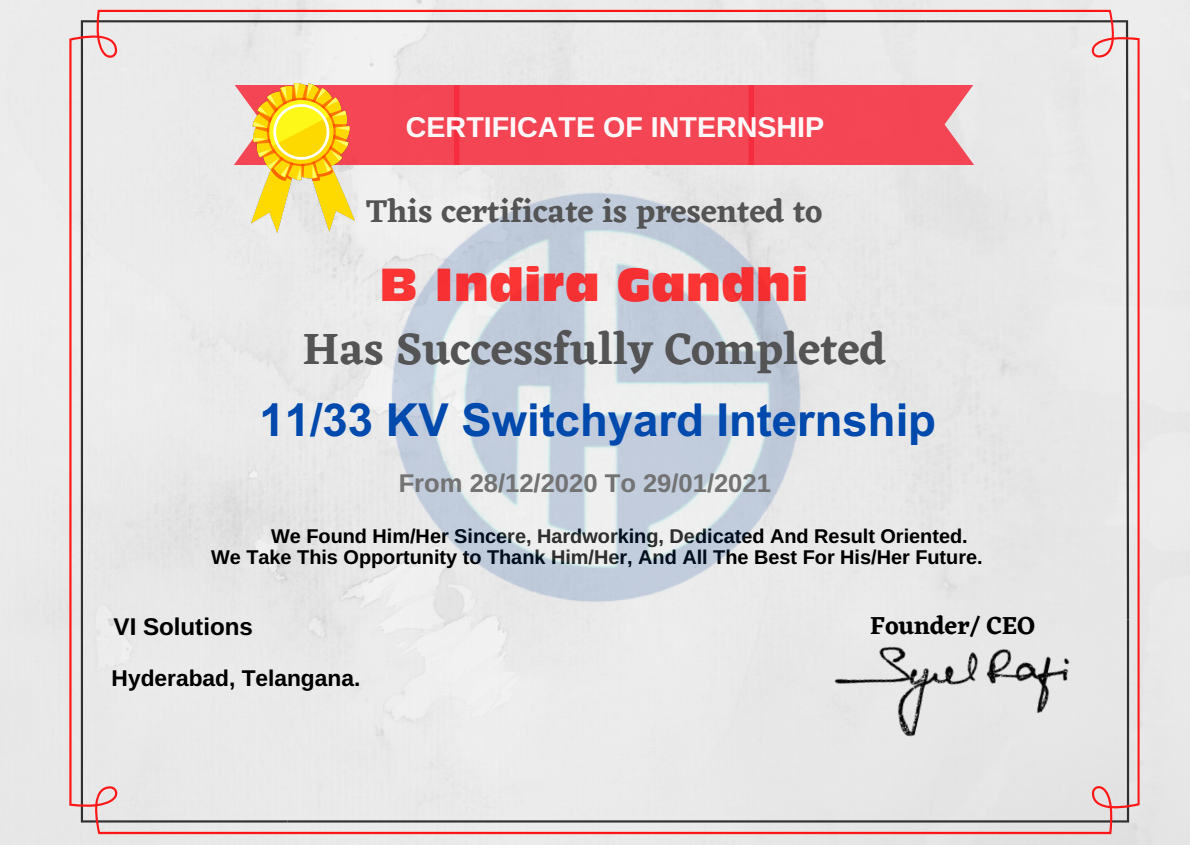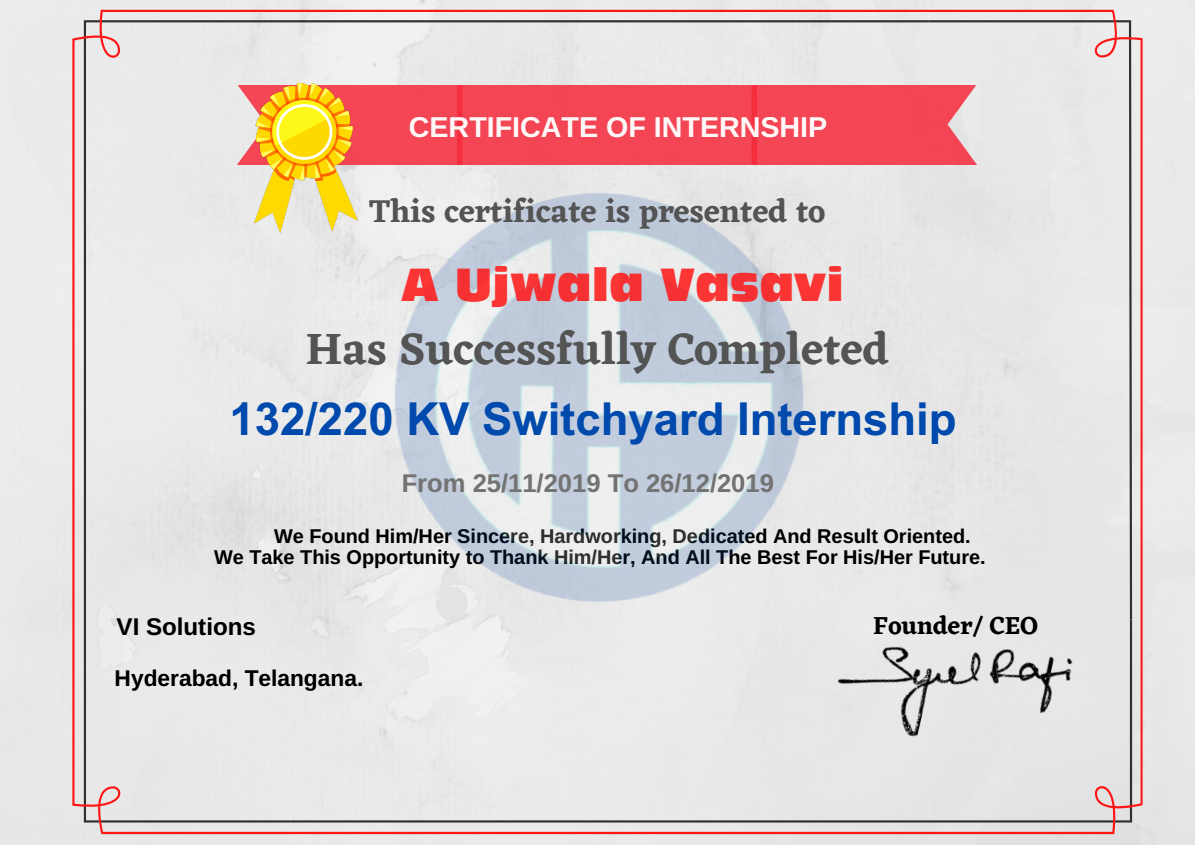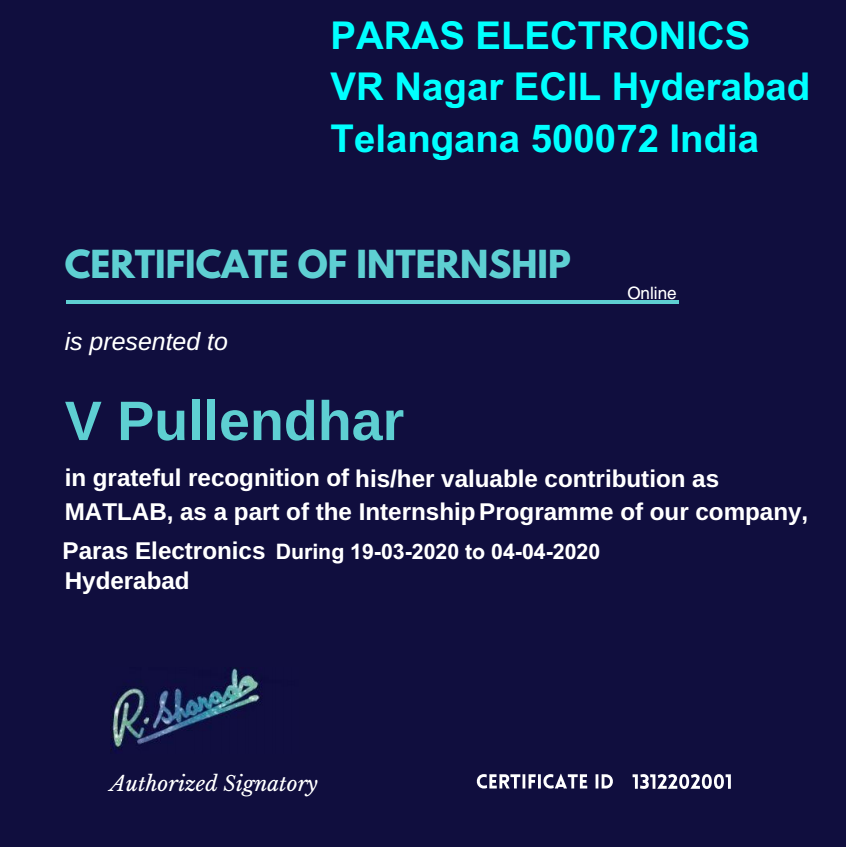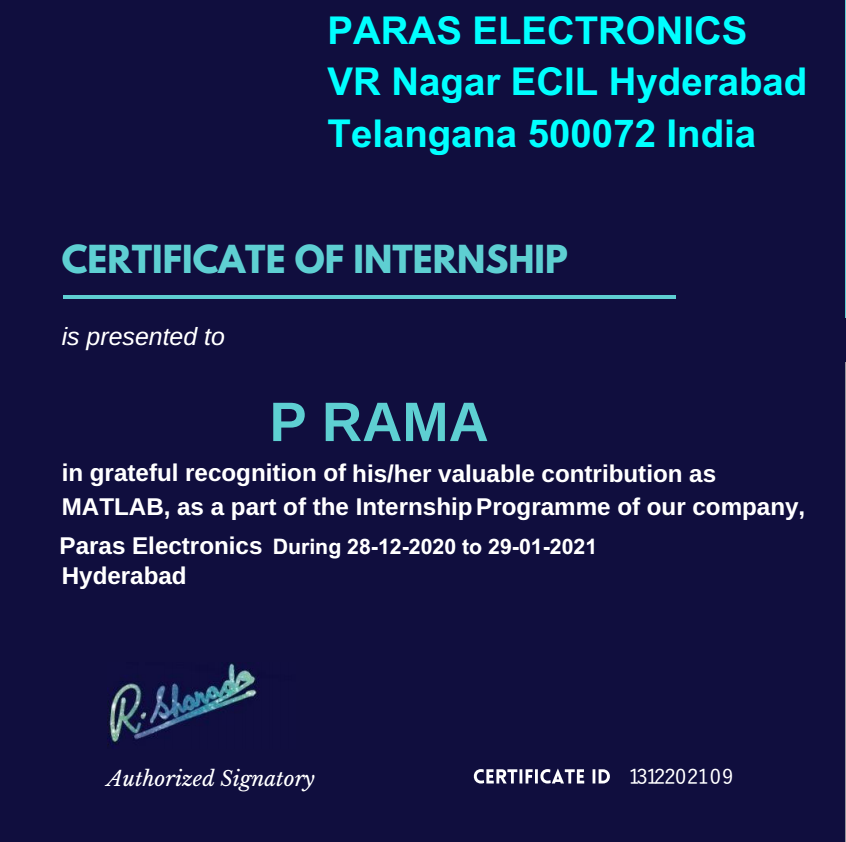Projects
DEPARTMENT OF ELECTRICAL AND ELECTRONICS ENGINEERING
Student Projects
Student’s carryout the project work during the IV year second semester, under the guidance of a faculty member. Every faculty member, in consultation with the allotted students, should define the project and also the probable procedure of carrying it out and submit the same to a committee consisting of 2 to 3 faculty members appointed by Head of the Department. This is to avoid the repetition and also to come up with a roadmap for completion of the project within the time stipulated. The students are encouraged to select topics related to ongoing research and consultancy projects in the University.
- Projectidentification (related to subjects, industrial projects etc.)
Student projects are divided into groups, depending upon the availability of specializations in the department, for major projects.
- Micro-grid
- Detecting, classifying and locating the faults in micro-grids
- Trading energy and detecting islanding
- Constructing energy storage devices
- Management of micro-grid energy
- Electric vehicles
- Management of charging period and optimal sessions
- Intelligent charging of Electric vehicles
- Advanced support for forecasting
- Estimating the state of power systems
- Forecasting loads and demands
- Predicting the amount of renewable energy capacity like speed,
- PV power and wind power
- Monitoring the quality of power
- Power quality cause monitoring
- Power quality event monitoring like swelling, notch, harmonics, voltage sag etc
- Other applications
- Fuel cells and detecting outages
- Estimating interval state
- Wind turbine anomaly detection
- Computing cognitive aspects in Internet of Things
- Response to demands
- Process of allotment of projects
- Aproject coordinator, who is a senior faculty member in the department, is entrusted with the job of projects allotment and monitoring.
- Majorprojects, in the IV year II semester of the program, students have the choice either to execute an in-house project under the guidance of a faculty
- Students, who chose to execute a project in the department, can then opt to become a part of an ongoing research project, if any, in the department or can contact faculty members for project supervision in the available specializations.
- Students are divided into groups, with a maximum of 5 students per group. The students choose their supervisor and topic as per their field of interest.
- There is no compulsion at the departmental level regarding the choice of supervisor or topic, however sometimes project coordinator may change the topic and assign new supervisor to balance the project load among all the faculty members of the department.
- Then a project proposal is submitted to the prospective supervisor for his perusal.
Depending upon the feasibility of the proposal, it is further submitted to the project coordinator for approval. The proposal includes a summary and the breakup of the cost of project
- After project coordinators’ approval, the students start the literature survey to clearly define the problem and design of the project.
- Course coordinator and the project coordinator ensure that both the minor and major projects are designed keeping in view the POs and PSOs of the program.
- Progress of the Project is monitored in two reviews by the project evaluation committee comprising of HOD, project supervisor and a senior faculty in the department.
- Continuous monitoring and evaluation of projects
Major projects are continuously monitored in different reviews by the committees constituted By the Head of the Department .
- Project students are expected to meet the respective project supervisor at least thrice in a week and explain the progress made from the previous.
- Working models as a result of the project, if any, will be evaluated based on the demonstration of the model with regard to specified objectives.
- Monitoring and evaluation of major projects
- Progress ofthe major project is reviewed three times in a Project coordinator organizes the major project review meetings with the Project Evaluation Committee(PEC) constituted by the head of the department.
- The project evaluation committee consists of the following members.
Head of the Department – Chairman
A senior faculty member identified by the HOD – Member
Project Supervisor – Member
Project Coordinator – Member
- The majorprojects are evaluated in three phases, two internal and final external review
- Forinternal review:
Four-member committee comprising of HOD, one senior faculty member, Project Guide and the project coordinator
- Forexternal reviews
Four-member committee comprising of senior faculty member, Project Guide, project coordinator and external expert.
- Review schedules of PEC are to be announced by the department immediately after the commencement of class work. Review parameters are given below
Review-1
- Identificationof specific area out of broad areas under the supervisor, outcomes In line with program objective
- Identificationof tools/equipment/training needs/ etc.
- Completion of literature survey
- Designof equipment set up
- Readiness of about 50% documentation
- Progress review as per mechanism/ schedule identified
- Individual student contribution
- Structure of project report
Review-2
- Presentation of results and conclusions
- Meeting of objectives defined in first review
- Acquisition/learningof the tool required
- Preparationof report
- Individualstudent contribution
- Progressof project as per schedule
Internal Marks Evolution
HOD | Dept. Senior Faculty | Project Guide | Project Coordinator | Total |
5M | 5M | 10M | 5M | 25M |
External Marks Evolution
Dept. Senior Faculty | Project Guide | Project Coordinator | External Examiner | Total |
10M | 20M | 10M | 35M | 75M |
RUBRICS FOR ASSESSMENT OF MAJOR PROJECTS
Category | Needs Improvements | Acceptable | Proficient |
Purpose of the Project | Does not clearly explain the intended outcome of the project or provides little information about the problem that was being solved, the need being met, or why the project was selected | Provides a description of the intended outcome of the project which includes information about the problem that was being solved or the need being met, and why the project was selected | Provides a detailed intended outcome of the project which includes information about the problem that was being solved or the need being met, and clearly articulates the reasons and decision-making process used to select the project |
Research | Lacks awareness of similar work done by others in an unacceptable literary form | Reflects awareness of similar work done by others and presents it in an acceptable literary format | •Reflects thorough understanding of similar work done by others and presents it in an acceptable literary format |
Choices | Lacks justification of choices with little or no references to functional, aesthetic, social, economic, or environmental considerations | Justifies choices made with reference to functional, aesthetic, social, economic, or environmental considerations | Demonstrates sophisticated justification of choices with reference to functional, aesthetic, social, economic, or environmental consideration |
Alternative Designs | Only one design presented or clearly infeasible alternative given. Serious deficiencies in exploring and identifying alternative designs. | Alternative approaches identified to some degree. | Final design achieved after review of reasonable alternatives. |
Application of Engineering Principles | No or erroneous application of engineering principles yielding unreasonable solution. Serious deficiencies in proper selection and use of engineering principles. | Effective application of engineering principles resulting in reasonable solution. | Critical selection and application of engineering principles ensuring reasonable results. |
Final Design | Not capable of achieving desired objectives. | Design meets desired objectives. | Design meets or exceeds desired objectives. |
Project Batches for the A.Y-2022-23
S.NO | BATCH NAME | PROJECT TITLES |
1 | 19QT1A0202- DANDU SINDHU PRIYA 19QT1A0205- VANKUDOTHU RAJESH 19QT1A0235- KOTHAPALLI AKASH 20QT5A0213- KONDE NARSIMHA RAO 20QT5A0217- DOLLA HIMACHANDANA | “IOT Based Power Theft Detection” |
2 | 19QT1A0211- ARZOO GUPTA 19QT1A0219- SIRISOLLA LAXMI LAVANYA 19QT1A0230- ETTI LOHIYA 20QT5A0205- VEMULA PRANAY KIRAN 20QT5A0218- NEERUDU KARTHIK | “IoT Based substation monitoring and control system” |
3 | 19QT1A0212- SAYYED NAZIYA 19QT1A0233- BODA RAJESH 19QT1A0244- KALLURI SANDEEP 20QT5A0201- BONKURI SAMARPAN 20QT5A0216- CHINTA MOUNIKA | “A Study on Induction Motor Efficiency Improvement for Implementing in Electric Vehicle” |
4 | 19QT1A0215- MOHAMMED HUSNA 19QT1A0203- JILLEPALLI KUJITHA 19QT1A0206- THALLA SANDEEP 19QT1A0214- GOVVALA LAVANYA 19QT1A0218- TALAMALA ABHIRAM | “A bidirectional DC-DC converter fed separately excited DC motor electric vehicle application” |
5 | 19QT1A0220- KANUKUNTLA POOJITHA 19QT1A0209- MITTAKOLU CHANDANA PRIYA 19QT1A0216- BATTULA VASU 19QT1A0238- BETHAMPUDI NIHARIKA 20QT5A0220- VELISALA DANIL MURALIKRISHNA | “Implementation of PNN Based AVR For Excitation Control System” |
6 | 19QT1A0221- BARLA AHALYA 19QT1A0210- YALAMANDALA SUPRIYA 19QT1A0217- BHUKYA VASU 19QT1A0228- NUNAVATH SWARNA BINDU 20QT5A0219- MADDISETTI RAVITEJA | “Power System Stabilizers for Inverter Dominated Future Power Systems” |
7 | 19QT1A0222- KASIMALLA MANEESHA 19QT1A0227- KALAVA PAVAN KALYAN 19QT1A0229- KODURI PAVAN KUMAR 19QT1A0239- DODDA PRANAY KUMAR 20QT5A0208- BODA SONIYA | “Power Quality Enhancement in PV and Battery Storage Based Microgrid Using Hybrid Active Filter” |
8 | 20QT5A0203- KAKI VASANTHA 19QT1A0208- ENDRALA BHAVANA 19QT1A0232- TEJAVATH NAVEENKUMAR 19QT1A0241- BORRAJU SRUTHI 20QT5A0214- BHUPELLI DHEERA MANAS | “Reduction in Microgrids Voltage Dips Based on Power Accumulators and Controlled Distributed Generation Plants” |
9 | 20QT5A0204- YADELLI SUHASINI 19QT1A0223- PULLURI JAYASMITHA 19QT1A0231- BHUKYA NAGA SWARUPA 19QT1A0234- SANGLOTH YAKU 20QT5A0207- BADDAM VENU REDDY | “Nested Neutral Point Clamped Converter Based DSTATCOM with Mixed-Sequence Reactive Current Compensation Capability” |
10 | 20QT5A0209- THATINI RAVICHANDRA LOKESH 19QT1A0207- DESABOYINA GEETHIKA 19QT1A0237- KOLICHALAM KARTHEEK 19QT1A0243- SHAIK SAFIYA 20QT5A0215- THALARI MADHU BABU 18QT1A0232- BODA PAVAN KALYAN | “BLDC Drive Control using AI Techniques” |
11 | 20QT5A0210- PAYAM ANIL DEEPAK 19QT1A0213- TEETLA MADHUSRI 19QT1A0225- BANOTH NEERAJ KUMAR 19QT1A0226- MUKKERA SAIKUMAR 20QT5A0206- RUNJA RAMU | “Simulation Model of Autonomous Solar Power Plant with Dual-Axis Solar Tracker” |
12 | 20QT5A0211- DHARAMPURI SATYA SRI 19QT1A0204- KANDULAPATI RAJESH 19QT1A0224- THALARI CHANDU 19QT1A0236- MALOTH NANDINI 20QT5A0202- PIRUMALA RANESH | “Development of an IoT based solution for Smart Distribution System” |
13 | 20QT5A0212- KAMA SARVESH BABU 19QT1A0201- PACHIPALA PAVANI 19QT1A0240- GUDIVADA SAMPATH KUMAR 19QT1A0245- GUJJARLAPUDI SUHAS 19QT1A0246- KORRA SRAVANTHI | “Analysis Modelling and Implementation of a Switching Bidirectional Buck-Boost Converter for Electric Vehicle hybrid Energy Storage in V2G System” |
DEPARTMENT OF ELECTRICAL AND ELECTRONICS ENGINEERING
Best Projects in AY: 2022-23
S.NO | BATCH NAME | PROJECT GUIDE | PROJECT TITLES |
1 | 19QT1A0211- ARZOO GUPTA 19QT1A0219- SIRISOLLA LAXMI LAVANYA 19QT1A0230- ETTI LOHIYA 20QT5A0205- VEMULA PRANAY KIRAN | Dr T RAKESH | “IoT Based substation monitoring and control system” |
2 | 20QT5A0203- KAKI VASANTHA 19QT1A0208- ENDRALA BHAVANA 19QT1A0232- TEJAVATH NAVEENKUMAR 19QT1A0241- BORRAJU SRUTHI 20QT5A0214- BHUPELLI DHEERA MANAS | K GOPALA KRISHNA | “Reduction in Micro grids Voltage Dips Based on Power Accumulators and Controlled Distributed Generation Plants” |
3 | 20QT5A0209- THATINI RAVICHANDRA LOKESH 19QT1A0207- DESABOYINA GEETHIKA 19QT1A0237- KOLICHALAM KARTHEEK 19QT1A0243- SHAIK SAFIYA 20QT5A0215- THALARI MADHU BABU 18QT1A0232- BODA PAVAN KALYAN | Y HEMAN | “BLDC Drive Control using AI Techniques” |
